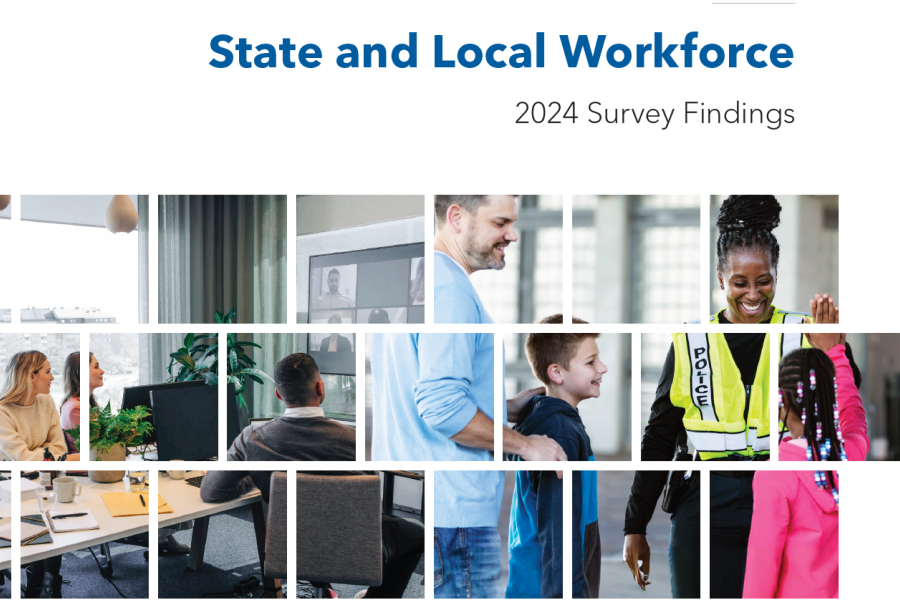As retirements peak, local governments are finding ways to recruit, retain employees

By KATE COIL
TT&C Assistant Editor

As the silver tsunami begins to crest, state and local governments are finding incentives like hybrid and shortened work schedules, increased compensation and wages, and changes to educational and civil service requirements are making recruitment and retention less challenging.
Since 2009, the Mission Square Research Institute – in conjunction with the National Association of State Personnel Executives (NAPSE) and Public Sector HR Association (PSHRA; formerly IMPA-HR) - has conducted a workforce survey to highlight employment challenges facing state and local governments.
While all sectors saw employment downturns during the pandemic, it has taken governments longer to recover. Private sector workforce recovery was met by April 2022 while recovery thresholds weren’t met by state government until January 2023 and local governments until December 2023.
Since then, U.S. Bureau of Labor Statistics reported some government departments have even expanded staff past pre-pandemic numbers, such landscaping and groundskeepers, computer and information systems, civil engineers, health workers, highway maintenance workers, accountants, librarians, and emergency services.
At the same time, governments have eliminated positions seen as outdated or better performed by technology. These positions largely included typists, file clerks, chief executives, customers service reps, receptionists, information clerks, office and billing clerks, secretaries and administrative assistants, buyers, purchasing agents, cashiers, and meter readers.
RATE OF RETIREMENT
With 2024 identified as the year the greatest number of Baby Boomers turned 65, 54% of local governments surveyed said they anticipate a large wave of retirements in the next few years.

As a result, 37% of local governments have reported succession planning is among their top concerns. However, only 12% of respondents have a succession planning process in place while only 20% are in the middle of developing such plans.
“If indeed the largest share of pending retirements is going to be occurring in the next few years, the completion of any formal or informal processes would help to ease that transition to the next generation of state and local government leaders and potentially also mitigate the exist interview concerns about a lack of internal advancement opportunities,” the report found.
Interestingly, the most common hiring practice reported by local governments in 2024 was the rehiring of staff members who had previously retired. This number was up to 37% in 2024 from 25% in 2022. This may be related to the fact that 48% of governments feel their employees are not financially prepared for retirement.
There are still more employees moving up their retirement date (26%) than postponing it (22%).
RECRUITMENT CHALLENGES
Hiring challenges remain in the areas of public safety, healthcare, and professional positions like engineers.

In the past year, the most difficult positions to hire for local governments were mental health professionals (83%), nurses (77%), corrections (74%), engineering (71%), policing (68%), skilled trades (65%), dispatchers (64%), building permitting and inspectors (55%), and driving/equipment operators with CDLs (55%).
Many reported issues attracting qualified candidates. The survey found 79% of police, 78% of engineering, 77% of nursing, 69% of corrections, 55% of maintenance, and 49% of IT applicants were deemed unqualified. Because of this, more than half of local governments reported having to either reopen or extend the application process with 41% doing so occasionally, 31% somewhat frequently, and 17% very frequently.
Others found outdated civil service requirements or job descriptions hindered filling positions. Nearly half (46%) of local governments reported updating job specifications to change minimum education, skills, or licensing requirements. Additionally, 29% said they dropped education requirements for at least some positions.
After changing educational requirements, 33% of governments said their number of applicants increased. While some HR officials expressed concern that dropping requirements meant hiring employees unable to perform their full duties, others said this allowed the hiring of individuals working to complete licensing before they were hired elsewhere.
The most successful locations for advertising positions to qualified candidates are:
- government websites (60%),
- social media (59%),
- employee referrals (57%),
- profession-specific media (39%), and
- commercial websites (39%)
BENEFITS AND COMPENSATION
Outside of retirement (32%), the most common reasons government employees gave for leaving positions were:
- uncompetitive compensation (41%),
- dissatisfaction with supervisors (30%),
- lack of internal advancement opportunities (28%),
- the ability to advance with another employer (25%), and
- personal/family priorities (23%).

Many local governments are recognizing the importance of wages and compensation to keep employees. Of local governments, 79% said a competitive compensation package was important to their organization and 73% said they felt their compensation is competitive.
Likewise, 60% said they felt their wages were competitive and 42% saw having pay equal to that of the private sector as important. To ensure this equity, 53% reported providing broad-based pay increases. The average broad-based pay increase offered was 4-6%.
To help with recruitment, a third of local governments (33%) also reported targeted hiring bonuses (33%).
The other large factor in recruitment and retention was a positive culture. Issues like employee morale (65%), employee development (60%), and employee engagement (60%) were among top priorities for government workforces.
Offering flexible work options is helping many governments accomplish this. More than half of local governments (51%) offer some type of hybrid schedule with the number even higher for state governments (85%). Additionally, 58% of local governments reported they offered flexible work days, such letting employees work 10 hours a day for four days.
Other common culture and morale-based benefits include:
- Employee assistant programs (EAPS) and mental health support (94%),
- Funds and reimbursement for training or tuition (73%),
- Employee development for leadership development (58%) or career paths (41%),
- Wellness programs (57%) and reimbursement (34%),
- Paid family leave (48%), and
- Offering employee-paid voluntary benefits (44%)

